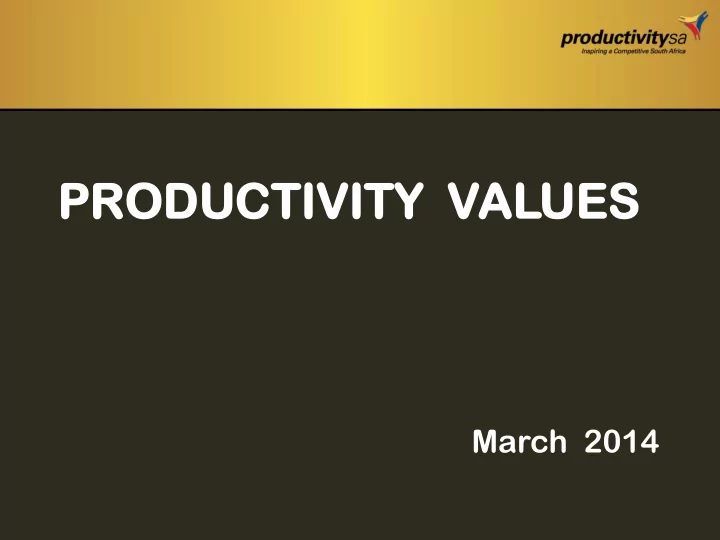

PR PRODUCTI ODUCTIVITY ITY VAL ALUES UES March 2014
PRODUCTIVITY SA - INTRODUCTION TRIPARTITE ADVISORY BOARD Enhancing the MANDATE Productive Capacity of South Africa To lead and inspire a VISION productive and competitive South Africa GOVERNMENT • Established through the Skills Development Act No 37 of 2008 as amended and is classified as a National Public Entity, under Schedule 3A of the Public Finance Management Act 1 of 1999
Training Agenda • What is productivity • Productivity explained • What is not productivity • Productivity explained in terms of embedded values: Continuous performance improvement Waste elimination Doing it right first time and all the time Cost reduction Continuous improvement of one’s own circumstances Efficient and effective resource usage Time management Environmental sensitivity Social conscience
What is Productivity? • Productivity entails converting resources (input) into products and services (output) efficiently, effectively and with optimum utilisations of human capital and physical resources for the benefit of society, the economy and the environment. A mind- set that embraces the value of “doing what I do today better than I did yesterday and even better tomorrow” That is, continuous performance improvement Its essence pivots around the Output/Input ratio and other forms of measurement
Productivity Explained • Doing the right things (effectiveness) • Doing things right (efficiency) Without waste of resources Within agreed time Correctly in terms of quality specifications With optimum utilization of people and Resources With respect for human dignity and the environment Tracing each improvement level
Productivity Explained
What is not productivity? • Working harder • Cutting costs • Reducing staff and workers • Extra work for managers • Employing specialists • Production .
What is not productivity (continued)
What is not productivity (continued)
Productivity values • Productivity improvement initiative incorporates simulation exercises which will allow pupils to find out what happens in a working and business environment as well as what is expected from people doing work in that environment. This will also provide employees with insight on strategies • Productive behaviour, like any other behaviour, is based on values that are assimilated into the people exhibiting productive behaviour
Continuous performance improvement • "doing what I do today better than I did yesterday and even better tomorrow". • Change your own circumstances • Finding easier ways to do things so as to improve output, quantity and time • Finding better or improved ways to do things to improve quality • The PDCA cycle for continuous improvement is the underlying system for setting goals
PDCA CYCLE
Continuous performance improvement
Waste elimination • Activities that do not add value to the end product or service. • Identifying and eliminating waste in all the things we do • Not forgetting to look for waste in all the things we do • Measuring waste where its being identified
Waste elimination
Doing it right, first time and all the time • Doing things once and getting them right all the time, and not repeating the same thing in order to get it right • One needs to be result driven and always achieve desired results • Accuracy, quality cost and speed
Doing it right, first time and all the time
Cost reduction • This is the process of looking for, finding, and removing unwarranted expenses to increase profits without negative impact on quality • By ensuring that what we do, does not result in waste of resources, energy, space and time
Cost reduction
Continuous improvement of one’s own circumstances • Making the most of opportunities to learn and improve • The future is tomorrow, and it depends on the things we did yesterday and the things we do today • The seeds that will bear fruit tomorrow are planted today • A bird in hand is worth two in the bush;
Continuous improvement of one’s own circumstances
Efficient and effective resource usage • Ensuring the products and services meet market expectation and are value for money. Doing the right things right (efficiency), which includes: • With the least possible waste of resource or input Within a short time • With high quality • With the highest use of human capital and resources • With the highest satisfaction for customers and employees • With respect for all.
Efficient and effective resource usage
Time management • The act or process of planning and exercising conscious control over the amount of time spent on specific activities especially to increase effectiveness, efficiency or productivity • Start a task on the agreed time and not after or before an instruction is given • Planning our day to make sure there is enough time for the things we need to do – eliminating human frustration
Time management
Environmental sensitivity • Most of the physical resources are derived from the environment. The ways of resources usage can either deplete or conserve environmental resources • Keep everything as clean as possible and conserve the environment
Environmental sensitivity
Social conscience • The improvement of productivity should benefit and not harm society • We must respect the dignity of all people, regardless of race, age, religion or status in society and treat people as equals • I am because we are (Motho ke motho ka ba bangwe) • Treat other people the way you would like to be treated
Social conscience
THANK YOU
Recommend
More recommend